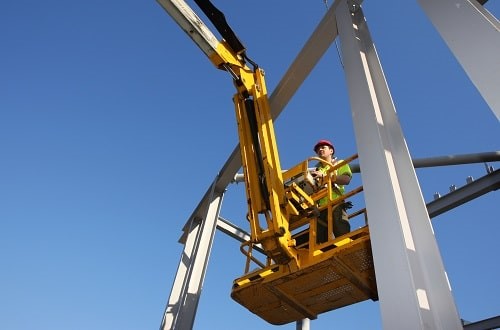With recent statistics showing little improvement in the number of workplace falls from height, the Access Industry Forum (AIF) believes a simplified incident reporting system for falls would allow lessons to be learned about the causes and most effective preventive measures.
Opinion
Simplified reporting of falls from height will identify ways to prevent accidents
The Access Industry Forum, the forum that represents the principal work at height trade associations and federations, is calling for clearer reporting of workplace accidents in a bid to save lives.
As latest Health and Safety Executive (HSE) statistics show another year of little improvement in workplace falls from height, the AIF is urging government and business to work together to spearhead action and prevent accidents.
HSE statistics published in November 2023 report that more than 5,000 people in Great Britain were injured at work in 2022/23 due to a fall from height. Forty people also lost their lives¹. These incidents are required by law to be reported by employers through RIDDOR², but the AIF knows there is substantial under-reporting of non-fatal falls from height for all workers, particularly the self-employed, who were found to report just 12 per cent of workplace incidents³.
 AIF is calling for a simplified system of reporting falls from height. Photograph: IPAF
AIF is calling for a simplified system of reporting falls from height. Photograph: IPAF
In addition to employer-reported RIDDOR incidents, the HSE estimates the scale of non-fatal workplace injury using their preferred source, the self-reported Labour Force Survey (LFS). According to the LFS, the number of falls over the past 10 years may be up to 425,000⁴.
Along with the lives, families and businesses affected by these accidents, up to 992,000 working days were lost through non-fatal falls from height in Great Britain in 2022/23 alone⁵.
Not only that, the total cost of non-fatal falls that year was estimated to be over £770 million, made up of costs to the employer and the individual, government tax losses and benefit payments⁶.
These figures have been consistent over recent years, with no signs of improvement.
Limited data available
Research undertaken by the AIF found that limited data collected on the circumstances surrounding accidents, coupled with a problematic reporting system, make it difficult to pinpoint the underlying causes of falls from height and identify whether they are related to issues such as faulty equipment, lack of training or negligence.
The AIF is therefore renewing its call for a simplified system of reporting to more accurately reflect the cause of workplace accidents so that informed, preventative measures can be implemented to address the cause of fall from height incidents.
Several government agencies and organisations collect elements of accident data (including on falls from height at work) with varying effectiveness. We are therefore calling for the introduction of simplified reporting without an additional burden on industry, through RIDDOR, which would record key data, such as the scale of a fall, the work method used and the circumstances which led to the fall.
We are also calling for an independent body to be set up that would collect information about all near falls and accidents that do not qualify for RIDDOR reporting under the current regime. The data collected by this independent body will be shared with government and industry to inform health and safety policy.
 Peter Bennett OBE is chair of Access Industry Forum (AIF). Photograph: AIF
Peter Bennett OBE is chair of Access Industry Forum (AIF). Photograph: AIF
A simplified system of reporting would help regulators to gain a better understanding of where to focus interventions and planned work; and, through improvements to work practices, alleviate pressure on a stretched healthcare system due to fall injuries. It would also enable shared learning, allowing the work at height and related industries to improve products and adjust training to keep people safe.
Unlike most other types of workplace injury, the consequences of a fall from height are usually life-changing for the person involved, with many unlikely to return to their previous occupation, as well as having long-term consequences for employers, colleagues and families.
The AIF actively supports the work of the All-Party Parliamentary Group (APPG) on Working at Height, which brings together MPs and stakeholders from across industry. At the Group’s recent meeting in December at Westminster, they discussed how government and business can work together to ensure technological and regulatory progress is made to make the UK the safest country in the world for those working at height.
This year’s work at height accident statistics from HSE show that there is much work still to be done to ensure those who have to work at height do so in as safe an environment as possible. Very little information is provided on the circumstance around non-fatal and fatal incidents, with current reporting focused on the type of incident as opposed to what caused it in the first place. This needs to change if we are to see a decrease in the number of people who tragically lose their lives while working at height, and those who suffer the life-changing consequences of a fall from height.
We know that working at height can be dangerous, but we should be able to put appropriate and robust measures in place to make it safer. We will continue to urge lawmakers to implement a simplified reporting system which will help ensure all those working at height go home safely at the end of the day.
Peter Bennett OBE is chair of the Access Industry Forum.
The AIF is the forum for the 10 principal trade associations and industry bodies involved in the provision of equipment and methods to allow individuals to work safely at height. Each AIF member organisation represents a different sector of the work at height industry and are recognised leaders in their respective fields.
For more information see: accessindustryforum.org.uk
Sources
- RIDDOR – Kind of accident statistic in Great Britain, 2023, hse.gov.uk/statistics/tables/index.htm
- Reporting of Injuries, Diseases and Dangerous Occurrences Regulations
- Health and Safety Executive Research Report RR528 An investigation of reporting of workplace accidents under RIDDOR using the Merseyside Accident Information Model, 2007, hse.gov.uk/Research/rrhtm/rr528.htm
- Labour Force Survey, hse.gov.uk/statistics/lfs/index.htm
- Labour Force Survey, hse.gov.uk/statistics/lfs/index.htm
- HSE Costs to Britain Model, hse.gov.uk/statistics/cost.htm
OPINION

Rethinking workplace wellbeing for a new era
By Kate Field, BSI on 16 June 2025
Today’s workers increasingly value the flexibility to pick the most suitable working model for their needs – whether this be hybrid, fully remote or site-based. However, new BSI research shows a more important consideration is working for an organisation that genuinely prioritises employee wellbeing, offers development opportunities and encourages staff autonomy.

The great training gap: 2.4 billion reasons to rethink safety education
By Mike Robinson FCA, British Safety Council on 10 June 2025
In a world beset by change, uncertainty and unpredictability, the power of education to create safer and healthier workplaces remains a constant.

Abuse of shopworkers continues to rise – more needs to be done
By Paddy Lillis, Usdaw union on 06 June 2025
Over half of retail workers have been threatened by a customer in the past 12 months.



